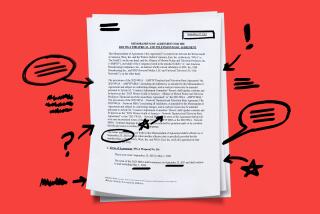Getting Down to the Details of TV Ratings
- Share via
Now that President Clinton has cleared the path for the TV industry to unveil the ratings system it has spent months devising, television executives must turn their attention to a host of unresolved issues regarding implementation of the plan.
Among the pressing issues is how the industry will ensure that the ratings standards are being applied equally by each programmer.
In part to test the consistency of application, each network was asked by the committee devising the ratings to provide a sample of how it would categorize its programs under the proposed categories.
In addition, because the broadcast and cable networks are ultimately responsible for policing themselves, the committee--led by Motion Picture Assn. of America Chairman Jack Valenti--is already working to establish a mechanism for the public and other networks to challenge ratings and monitor the system, including the establishment of an 800 number that viewers could call to register complaints.
“This is still being formulated, but what we’re going to do is have a monitoring group to take a look at complaints and make sure the ratings are consistent,” a committee source said. “The whole system is voluntary, so you can’t force someone to change their rating. But the public is going to be watching. And if a rating is way out of line, there would be pressure on a network or producer to do the right thing.”
Another committee member said an additional purpose of the sample ratings was simply to have examples at this Thursday’s news conference officially detailing the system, anticipating that specifics on how certain shows will be rated will be “question No. 1.”
On Friday, at a press conference in which he unveiled several cabinet member choices for his second term, President Clinton expressed his support for the Valenti plan, saying it should be given a chance to work before modifications are made.
Elements of the plan have been disclosed in newspaper reports and have drawn criticism from some children’s advocates and politicians for relying on a system of categories predicated on age, similar to the MPAA’s movie ratings, as opposed to a content-based approach specifying levels of sex, violence and foul language.
Yet if the president’s comments seemed to give the Valenti group ammunition in dealing with its critics, the industry is still faced with the daunting logistics of putting the plan into operation.
At times overlooked, in fact, have been the challenges in rating thousands of television programs each year. Each broadcast and cable network will be responsible for rating its own entertainment programs using the agreed-upon standard. ABC, CBS and NBC each carry more than 1,100 hours of prime-time programming per year, while Fox (which doesn’t program after 10 p.m.) carries nearly 800 hours. That doesn’t include having to rate daytime, late-night, syndicated and children’s programming.
While the networks declined to discuss the ratings until the system is formally announced, officials have indicated that the ratings code will be applied through their existing broadcast standards and practices departments--by personnel already charged with screening every program that airs to make sure it adheres to established content guidelines.
The expectation is that each prime-time series would be assigned a general rating based on its usual content parameters--a designation that could be revised if an individual episode crosses that line.
Committee members have indicated that a show like CBS’ “Cybill” would probably carry a PG (parental guidance) rating most of the time but might carry a stronger PG-14 (parents strongly cautioned) if an episode were deemed to be especially saucy or risque. Other series, such as Fox’s “Melrose Place,” ABC’s “NYPD Blue” and Fox’s “The X-Files,” are expected to carry the PG-14 designation on a regular basis.
Although some observers have suggested that rating programs will actually liberate producers in pressing the boundaries of what’s acceptable, network sources stress that existing standards will not be relaxed because of the ratings system.
“Nothing is going to change--it’s not as if the floodgates are going to open,” one network representative said. “[Programs] will still have to pass our broadcast standards and practices.”
Indeed, the concern among producers is precisely the opposite: that networks will want to edit programs specifically to get a lower rating, especially if stronger designations are shown to frighten away advertisers. Some also wonder whether the standards departments will find themselves pressured, tacitly or otherwise, to use less restrictive ratings in order to make programs more attractive to advertisers.
Such negotiations with producers--toning down content to achieve a lesser rating--regularly occur under the movie rating system. Major studios often contractually compel filmmakers to make revisions that would secure an R rating, as opposed to the more restrictive and thus commercially damaging NC-17.
Similarly, TV producers regularly wrestle with program standards over their shows, so such fracases will be nothing new as they apply to ratings.
Executives have insisted in the past that although broadcast standards departments interact with the sales force, they cannot be compelled to withhold or soften labels. “If something deserves to have an advisory, I don’t think I’ve been questioned by anyone in the company,” Carol Altieri, vice president of program practices at CBS, said in an interview last October, referring to parental-discretion advisories.
Other questions regarding practical implementation of the ratings plan remain unanswered. It’s unclear, for example, whether all advertising would list the rating, or if changes could be made on series that are delivered after the deadlines of newspaper and magazine TV listings, which frequently are assembled more than a week in advance of publication.
The expectation is that programs will be aired with a small graphic in the lower corner, known as a “bug,” alerting viewers to the rating as the show begins. Networks already use such graphics with their on-air logos to establish their brand identity with viewers, and ABC recently expanded the practice by using a graphic showing parents and children on programs deemed “family friendly,” such as “Home Improvement” and “Family Matters.”
The ratings oversight committee not only will allow viewers to lodge complaints but also will let networks take issue with one another--which seems necessary in light of past disagreements. Some networks have charged that their competitors are more lax and permissive in regard to program content, demonstrated by NBC’s recent criticism of Fox for airing the specials “When Animals Attack” and “When Disaster Strikes.”
The oversight committee will have 19 members and be headed by Valenti. Six representatives will come from broadcast television, six from cable and six more will represent the production community, probably chosen from the writers, producers and directors guilds.
Times staff writer Jane Hall contributed to this report.
More to Read
The biggest entertainment stories
Get our big stories about Hollywood, film, television, music, arts, culture and more right in your inbox as soon as they publish.
You may occasionally receive promotional content from the Los Angeles Times.










